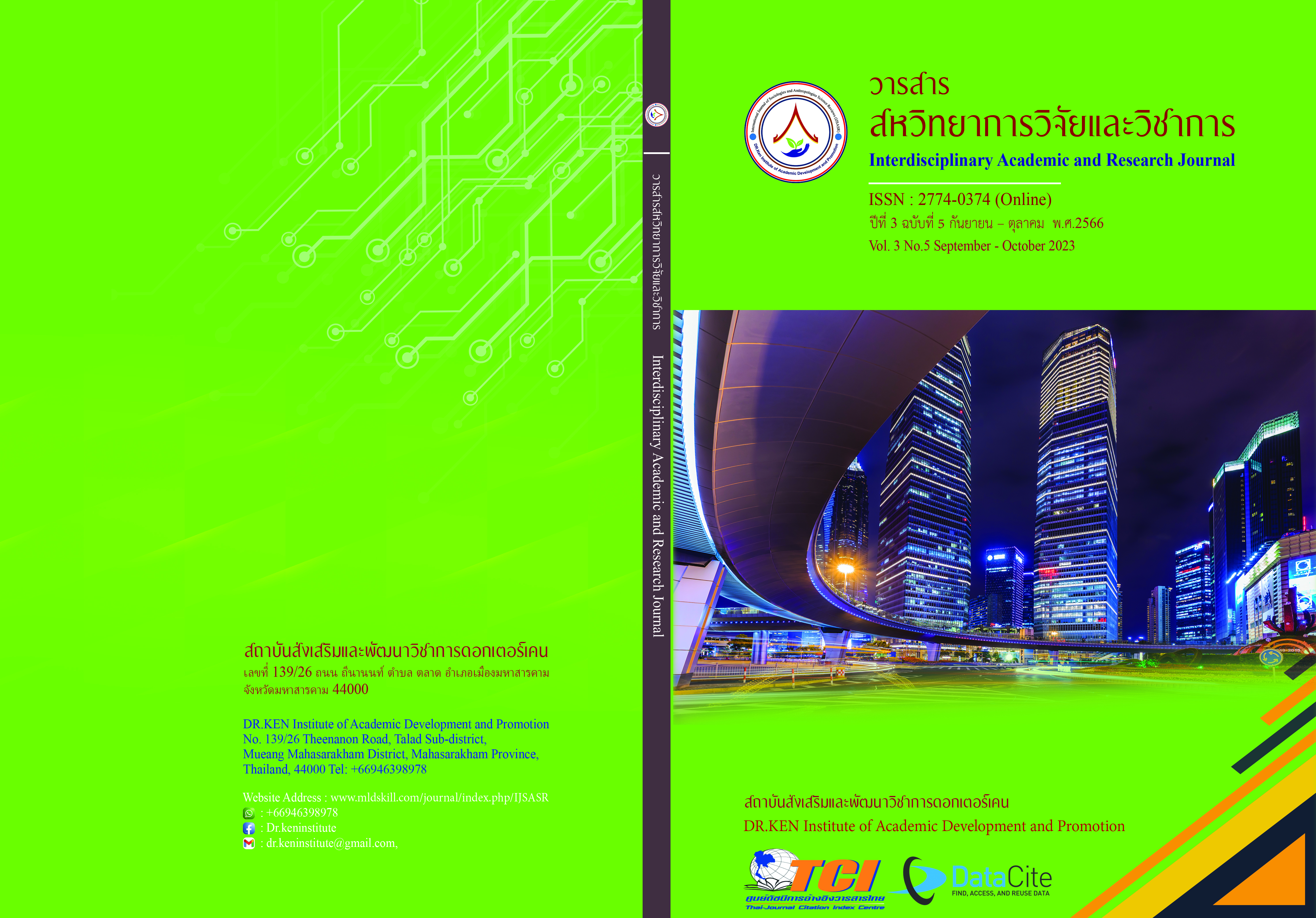A Study of Prathomsuksa 5 Students’ Mathematical Problem-Solving Ability on Percentage Word Problem by Using Online Active Learning
DOI:
https://doi.org/10.14456/iarj.2023.259Keywords:
Online Active Learning; , Mathematical Problem-solving Ability;, Percentage Word ProblemAbstract
One of the measures to control the spread of COVID-19 in an emergency in terms of public health is social distancing, a distance from doing activities between people. It causes changes in lifestyle, work, and education. In the part of education that cannot manage normal teaching and learning. In an online teaching format, the students learn on their own continuously, especially in math, which is an important basis for promoting skills and abilities for solving problems at the elementary school level. Therefore, the purpose of this research was to study Prathomsuksa 5 students’ mathematical problem-solving ability on percentage word problems by using online active learning. The sample was 33 Prathomsuksa 5 students in one classroom at Ritthiyawannalai School Bangkok in the second semester of the academic year 2020. The research instruments used in the experiment were 10 mathematics lesson plans on percentage word problems using online active learning. The research instruments used to collect data were 5 items with multiple choices of mathematical problem-solving ability on Percentage word problems. The statistics used in data analysis were percentage, mean, standard deviation, and t-test. The one-sample t-test is a statistical hypothesis test. The research findings related that the mathematical problem-solving ability of Prathomsuksa 5 students on percentage word problems by using online active learning was higher than 70 % at the .05 level of significance.
References
กระทรวงศึกษาธิการ. (2562). แนวทางการนิเทศเพื่อพัฒนา และส่งเสริมการจัดการเรียนรู้เชิงรุกหน่วยศึกษานิเทศก์. Retrieved January 15, 2021, from: http://academic.obec.go.th/images/document/1603180137_d_1.pdf.
กระทรวงศึกษาธิการ. (2563). แนวทางการจัดการเรียนการสอนทางไกลในสถานการณ์การแพร่ระบาดของเชื้อไวรัสโคโรน่า 2019 (COVID-19). Retrieved January 15, 2021, from: http://www.obec.go.th/archives/255396.
จิรชพรรณ ชาญช่าง. (2561). ผลของการใช้ชุดการเรียนรู้ผ่านแท็บเล็ตร่วมกับแนวคิดเกมมิฟิเคชันเพื่อส่งเสริมผลสัมฤทธิ์ และความคงทนในการเรียนวิชาคณิตศาสตร์ของนักเรียนชั้นประถมศึกษาปีที่ 4 ที่มีความสามารถทางการเรียนแตกต่างกัน. วารสารครูศาสตร์, 47(2), 18-30.
ญาณกวี ขัดสีทะลี. (2557). การจัดการเรียนรู้ด้วยเทคนิคเคดับเบิ้ลยูดีแอลเพื่อส่งเสริมทักษะการแก้ปัญหาและการให้เหตุผลทางคณิตศาสตร์ สำหรับนักเรียนชั้นมัธยมศึกษาปีที่ 3 โรงเรียนบ้านปง จังหวัดเชียงใหม่. วิทยานิพนธ์ศึกษาศาสตรมหาบัณฑิต สาขาคณิตศาสตร์ศึกษา, มหาวิทยาลัยเชียงใหม่.
มัณฑนา พรมรักษ์. (2556). ผลของการจัดกิจกรรมการเรียนรู้คณิตศาสตร์โดยใช้โมเดลการแก้ปัญหาที่เน้นกระบวนการการกำกับทางปัญญาที่มีต่อความสามารถในการแก้ปัญหาทางคณิตศาสตร์และความสามารถในการคิดอย่างมีวิจารณญาณของนักเรียนชั้นมัธยมศึกษาปีที่ 2. วิทยานิพนธ์ปริญญามหาบัณฑิต สาขาวิชาการศึกษาคณิตศาสตร์, จุฬาลงกรณ์มหาวิทยาลัย.
วุฒิชัย ภูดี. (2563). การสอนคณิตศาสตร์ในยุคดิจิทัล: วิธีการและเครื่องมือ. วารสารวิทยาศาสตร์และวิทยาศาสตร์ศึกษา, 3(2), 190-199.
สิทธิชัย สระตอมูฮัมหมัด. (2561). การพัฒนากิจกรรมการเรียนรู้โดยใช้เทคนิคเกมมิฟิเคชันเพื่อยกระดับผลสัมฤทธิ์ทางการเรียนวิชาคณิตศาสตร์ เรื่อง ระบบสมการเชิงเส้นชั้นมัธยมศึกษาปีที่ 3 โรงเรียนสวนกุหลาบวิทยาลัย [รายงานผลการวิจัย]. สำนักงานคณะกรรมการการศึกษาชั้นพื้นฐานกระทรวงศึกษาธิการ ในโครงการวิจัยพัฒนานวัตกรรมแลกเป้า สพฐ. ปีงบประมาณ 2561.
สิริพร ทิพย์คง. (2536). การแก้ปัญหาเอกสารคำสอนวิชา 158522: ทฤษฎีและวิธีการสอนคณิตศาสตร์. กรุงเทพมหานคร ภาควิชาการศึกษา. คณะศึกษาศาสตร์, มหาวิทยาลัยเกษตรศาสตร์.
อัมพร ม้าคนอง. (2553). ทักษะและกระบวนการทางคณิตศาสตร์ : การพัฒนาเพื่อพัฒนาการ. พิมพ์ครั้งที่ 1. กรุงเทพมหานคร: ศูนย์ตำราและเอกสารทางวิชาการ จุฬาลงกรณ์มหาวิทยาลัย.
Baldwin J, & Williams, H. (1988). Active Learning: a Trainer's Guide. England: Blackwell Education. Retrieved January 15, 2021, from: https://cft.vanderbilt.edu/active-learning/.
Polya, G. (1973). How to solve it: A new aspect of mathematical method. 2nd edition. Princeton, New Jersey: Princeton University Press.
Polya, G. (1985). How to Solve It. A New Aspect of Mathematical Method. 2nd edition. New Jersey: Princeton University Press.
Downloads
Published
How to Cite
Issue
Section
License
Copyright (c) 2023 Pannipa Fongchan, Songchai Ugsonkid, Tongta Somjaipeng

This work is licensed under a Creative Commons Attribution-NonCommercial-NoDerivatives 4.0 International License.
Copyright on any article in the Interdisciplinary Academic and Research Journal is retained by the author(s) under the under the Creative Commons Attribution-NonCommercial-NoDerivatives 4.0 International License. Permission to use text, content, images, etc. of publication. Any user to read, download, copy, distribute, print, search, or link to the full texts of articles, crawl them for indexing, pass them as data to software, or use them for any other lawful purpose. But do not use it for commercial use or with the intent to benefit any business.
















.png)


